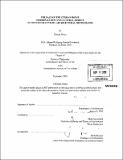| dc.contributor.advisor | Mark Jarzombek. | en_US |
| dc.contributor.author | Weiss, Kirsten (Kirsten Anne) | en_US |
| dc.contributor.other | Massachusetts Institute of Technology. Dept. of Architecture. | en_US |
| dc.date.accessioned | 2009-06-30T16:44:56Z | |
| dc.date.available | 2009-06-30T16:44:56Z | |
| dc.date.copyright | 2008 | en_US |
| dc.date.issued | 2008 | en_US |
| dc.identifier.uri | http://hdl.handle.net/1721.1/45942 | |
| dc.description | Thesis (Ph. D.)--Massachusetts Institute of Technology, Dept. of Architecture, 2008. | en_US |
| dc.description | Includes bibliographical references (p. 227-261). | en_US |
| dc.description.abstract | This dissertation proposes that architectural photography-which became an independent genre in twentieth century Germany-was a primary route along which the cultural and political conflicts of modernization were addressed within the contested space of public discussion, and that these photographs helped produce the political and cultural changes driving major developments in German architecture and urbanism since the 1920s. My study explores the history of the representational and disciplinary ambiguity between the house photograph and the portrait, with particular attention to political and social connotations in the work of four German practitioners whose photographic oeuvres are more closely related than is commonly understood: Paul Schultze-Naumburg (1896-1949), Albert Renger-Patzsch (1897-1966), August Sander (1876-1964), and Bernd Becher (1931-2007).My study of these figures' architectural photographs highlights their participation in broader debates on architecture and public space, specifically through the overarching metaphor of the "face" of the German building. I argue that the work of these photographers, as well as their circumstances of production, epitomize the concurrent and colliding forces of modernity and industrialization. | en_US |
| dc.description.abstract | (cont.) The understanding of the historical precedents and construction of the genre of German architectural photographs demonstrates the contentious issues surfacing in these four figures' work: Paul Schultze-Naumburg's obsession with facial and racial characteristics in portrait as well as architecture photography, Albert Renger-Patzsch's modernist attempt to purge these unsavory ideas by professionalizing architecture photography into an "objective" practice, the analogies to caricature and taxonomy seen in the ubiquitous systems of identification by August Sander, and, finally, the practice of Bernd Becher whose use of the rhetoric of standardization in his photographs of houses appears as a postmodern acknowledgment of the hegemonic achievement of modernization-of both Germany and architectural photography. Spanning the 20th century, the work of these four figures is anchored in a deep anxiety regarding the pace and culture of modernization in Germany; this dissertation challenges the boundaries set up between their respective bodies of work and charts a new history of architectural photography in Germany as a driving force of the volatile history of modernity. | en_US |
| dc.description.statementofresponsibility | by Kirsten Weiss. | en_US |
| dc.format.extent | 315 p. | en_US |
| dc.language.iso | eng | en_US |
| dc.publisher | Massachusetts Institute of Technology | en_US |
| dc.rights | M.I.T. theses are protected by
copyright. They may be viewed from this source for any purpose, but
reproduction or distribution in any format is prohibited without written
permission. See provided URL for inquiries about permission. | en_US |
| dc.rights.uri | http://dspace.mit.edu/handle/1721.1/7582 | en_US |
| dc.subject | Architecture. | en_US |
| dc.title | The face of the German house : modernization and cultural anxiety in twentieth-century architectural photographs | en_US |
| dc.type | Thesis | en_US |
| dc.description.degree | Ph.D. | en_US |
| dc.contributor.department | Massachusetts Institute of Technology. Department of Architecture | |
| dc.identifier.oclc | 320957458 | en_US |
